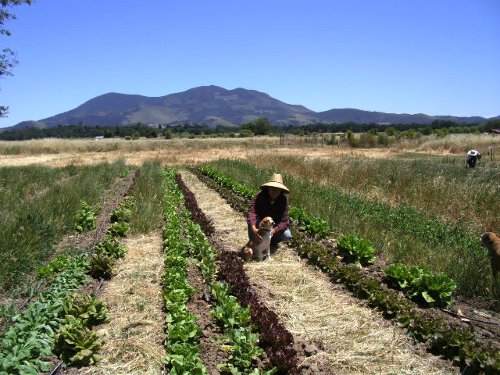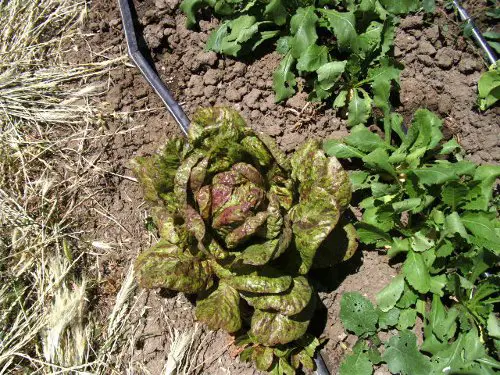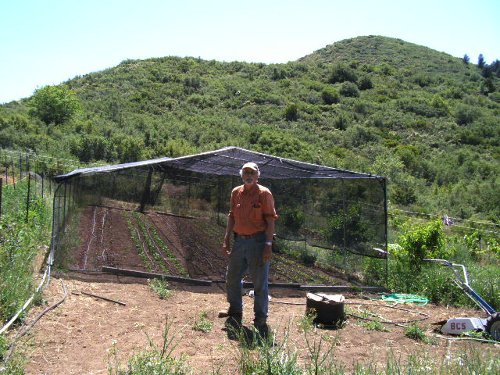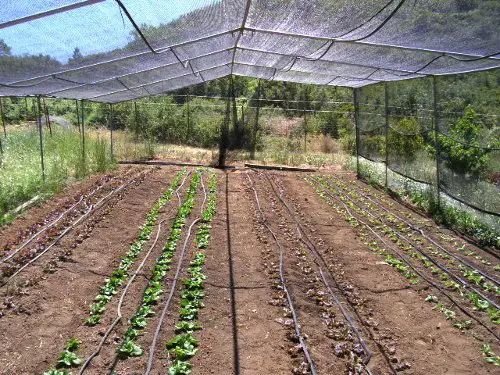
My high school science teacher, an avid fisherman, once told me that he liked my freckles because they reminded him of a “nice, speckled trout.” I’m not sure I liked being compared to a fish; however, I do enjoy sharing my freckled identity with a type of lettuce of which I recently became aware.
The lettuce in question is “freckled lettuce,” a variety with a loosely formed head that has red blotches on its green leaves. It caught my eye while perusing the stalls at a recent farmers’ market, and, as you can imagine, I was happily intrigued by its moniker. It’s grown by Full Moon Farm in Kelseyville, and when I visited the farm recently, I enjoyed seeing rows of these lettuces growing with Mt. Konocti as an impressive backdrop.
There are hundreds of varieties of lettuce. In 1885, there were 87 varieties identified in the U.S., and while that’s an admirable amount, we’ve come a long way since then.
As many types as there are, they fall into far fewer large categories, or cultivar groups.
Loose leaf (or simply leaf) lettuce doesn’t form heads, but its leaves are joined at the stem. Examples of this variety include oak lettuce and red or green leaf lettuces.
Romaine (or cos) lettuce has a long head with sturdy leaves which have a rib down the center. The outer leaves tend to be dark. This type has gained popularity because it’s the base ingredient for Caesar salad. Its crispy texture may appeal to those who like iceberg lettuce.

Lettuce in the Butterhead category has loosely formed heads, a buttery texture and mild taste. Boston lettuce, which is shaped like a blooming rose, and Bibb lettuce, which is cup shaped, are both examples of this type.
Chinese lettuces have long, sword-shaped, non-head-forming leaves with a bitter flavor. Unlike the west where lettuce is generally eaten raw, the Chinese use lettuce in stir-fried dishes and stews. (China is the world’s largest lettuce producer by far. The U.S. is a distant second, growing only half of China’s crop.)
Summer Crisp, or Batavian, forms moderately dense heads with a crunchy texture. This type is intermediate between iceberg and loose leaf types.
Finally, the Crisphead variety includes Iceberg lettuce. It is the least nutritious of the salad greens, has pale leaves, a cabbage-like head, crispy texture and mild flavor.
Lettuce is thought to have originated as a weed in the Mediterranean region and has been used in cuisine for about 4,500 years. Ancient Greek scholars identified different types of lettuces, and lettuce appears in tomb paintings in Egypt.
Christopher Columbus introduced lettuce to the new world. By the time Thomas Jefferson was president, he was growing 19 types on his farm at Monticello.
It’s interesting to note that both the Latin and English words for lettuce derive from “lac,” the Latin word for milk, possibly because of the milky juice of some varieties. In fact, in the earliest Egyptian tomb paintings, the ruler Senusret offers lettuce to the god Min, to whom milk was sacred.

Ancient Egyptians considered lettuce an aphrodisiac, and early Greek physicians thought lettuce contained a sleep-inducing agent. The Romans held to this belief, as well, and served lettuce at the end of the meal for this reason. (The custom of serving salad at the end of a meal continues in some European countries.)
The nutritional value of lettuce varies based on the variety. In general, lettuces with darker leaves are more nutrient dense than those with lighter leaves. For example, Romaine lettuce has eight times the beta-carotene, four times the calcium and two times the potassium as Iceberg lettuce.
The darker lettuces are good sources of vitamins A, K and C, folate, manganese and chromium. All lettuces are good sources of dietary fiber, even the nutrient barren Iceberg variety. They’re also low in calories and high in water content.
Lettuce aids digestion and promote liver health. Some research shows it helps reduce the risk of cancer and ease nervous insomnia (which gives credence to the theories of the ancient Greeks and Romans).
I had an opportunity recently to visit Love Farms at the base of Cobb Mountain in Lower Lake, where Teale Love has devised a way to grow lettuces in the shade in the height of Lake County’s summer heat.
Lettuce is typically a cool weather crop; its growth is stunted in the heat and the leaves grow bitter. Love’s shaded growing tent changes all this.
The tent material is netlike, with holes for the sun to penetrate. Even so, the temperature drops significantly when one steps into it. There are spray nozzles set up along its sides that emit a fine mist to keep the developing lettuces cool, even on the hottest of days.
Love spent last year testing his method using a dozen or more lettuce varieties. He kept careful track of which ones showed more tolerance to heat, eliminating the ones that didn’t do well. The result is that we will have a crop of heat resistant lettuces available to us at Lake County farmers’ markets through the summer. Hurrah!
The recipe I offer today is an unusual Thai appetizer served in lettuce leaves. It bursts with a variety of flavors; in fact, everything we can identify on our palates – sweet, sour, bitter, salty, umami (savory) and piquant – is represented in the lettuce wrap.
Lettuce leaves also make interesting wraps when filled with flavorful ingredients from other world cuisines, such as China or Mexico. Be creative – the possibilities are endless!
This recipe is from Mei Ibach, a Thai cuisine culinary instructor at SRJC, and some of the ingredients are found in Asian markets. (If you’d like a list of markets, please email me.)
For a vegetarian version, simply eliminate the dried shrimp and shrimp paste.
Miang Kam
Lettuce leaves, washed and patted dry, 20 or more
¼ cup fresh roasted peanuts
¼ cup fresh toasted coconut flakes
¼ cup fresh ginger, cut into a fine dice
¼ cup fresh lime, cut into the tiniest of wedges, leaving skin on
¼ cup fresh jalapeño chiles, cut into a fine dice (seed chilies if less heat is desired)
¼ cup dried shrimp (found in Asian markets)
To serve, lay all ingredients out artistically on a large platter. (Lettuce should be presented separately.)
To eat, put a pinch of each ingredient into a lettuce leaf, top with palm ginger sauce (recipe follows), wrap, and eat in one bite.
Palm ginger sauce
½ cup palm sugar (found in Asian markets)
½ cup water
3 to 4 slices fresh ginger
½ teaspoon shrimp paste (optional)
1 tablespoon tamarind juice (found in Asian markets)
¼ cup toasted coconut flakes
Salt and pepper to taste
Bring the water to boil in a small pot, then add the palm sugar and stir until dissolved. Add the ginger, tamarind juice, and shrimp paste and stir well. Add salt & pepper to taste. Simmer and reduce until mixture has thickened a bit. Add the coconut flakes just before serving.
Esther Oertel, the "Veggie Girl," is a personal chef and culinary coach and is passionate about local produce. Oertel owns The SageCoach Personal Chef Service and teaches culinary classes at Chic Le Chef in Hidden Valley Lake. She welcomes your questions and comments; e-mail her at This email address is being protected from spambots. You need JavaScript enabled to view it..
Follow Lake County News on Twitter at http://twitter.com/LakeCoNews and on Facebook at http://www.facebook.com/pages/Lake-County-News/143156775604?ref=mf .
